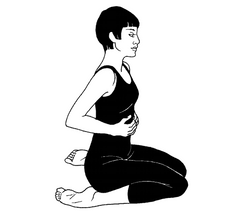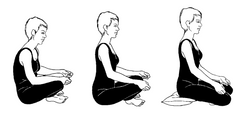Is Meditation Uncomfortable? Do You Have to Sit on the Floor?
No and no. Sometimes, physical discomfort is something you can work through in meditation, but the point is not “no pain, no gain.” Remember, the Buddha discovered asceticism wasn’t the way, but moderation was. That means don’t recline in a cushy armchair with your feet up (you’d soon fall asleep), but don’t sit on a bed of nails, either.
Although the floor often provides the best place to meditate (with the proper cushions), some people can’t sit on the floor for whatever reason and a chair works just fine, too. Even lying down can work, particularly for the yoga style of relaxation/meditation called shavasana. Technically, lying down to meditate isn’t zazen, since zazen means sitting meditation. However, as we said before, if lying down is the only thing that works for you, then that is your zazen.
Are You Supposed to Meditate with Your Eyes Open or Closed?
That depends on your personal preference. Although the traditional zazen technique is to keep eyes unfocused, directed slightly downward, and only partially closed, some people keep them all the way open and others like to close them.
Meditation Pose
Let’s start with the basic form for zazen. In traditional zazen, you would use a large rectangular mat called a zabuton, and then place a small round cushion, called a zafu, on the mat. The zafu is where you sit. For the traditional Japaneses sitting pose (see the diagrams that follow) you can also purchase (or build) a meditation bench, also called a seiza bench, which is a low angled bench for sitting with your legs folded under the bench, so you don’t actually have to sit directly on your legs or bend your knees quite as much.
If you don’t have this equipment (which is pretty expensive whenever we’ve seen it), you can use a regular exercise mat, carpet, or blanket, and a couch cushion or folded bed pillow. (The Buddha didn’t have to order any equipment from any New Age catalogue, so you shouldn’t have to, either, unless you really want to spend the money).
Now you want to make a tripod, so your weight is evenly distributed on each knee and on the cushion (on which you are sitting) or bench. Two positions are the most stable: the lotus pose and the Japanese sitting pose.
The Lotus Pose
The lotus pose is popular among Zen practitioners and is infamous for being difficult to achieve. In this pose, you sit cross-legged with each foot on top of the opposite thigh. Once you’ve achieved a degree of hip flexibility, the position isn’t difficult at all, and is perfect for zazen because it puts the body into a very stable, solid, steady position, making it easier to keep the head up, the spine straight, and the concentration intact. It also twines the legs so that right becomes left, left becomes right, which is a satisfying metaphor for the balancing effect of zazen.For people who practice yoga regularly or who are otherwise particularly limber, the lotus pose might be a breeze. If you can’t get into it, though, you are certainly not disallowed from practicing zazen. You just need to sit in a different way.

Japanese Sitting Pose
In Japan, the favored meditation position is the traditional Japanese sitting pose. For Japanese sitting pose, sit on the cushion with your knees bent and each heel and calf tucked under each thigh. (If not for the cushion, you would be sitting on your heels.) This pose gives you the same stable position with the weight on the cushion and
both knees, putting less stress on your knees than crossing your legs. Just be sure not to open your feet out to the side, which can be hard on your knees. Your heels and calves should be right under your thighs.

Other Ways to Sit
Sitting in the full lotus pose takes a lot of flexibility in the hips, knees, ankles, and feet, more than some people have at first. If you aren’t comfortable in the lotus pose, you have some other sitting options:➤ Half lotus. In this pose, you sit on your cushion and put one foot on top of the opposite thigh and leave the other foot under its opposite thigh. After a time, when your legs get tired, you can switch sides.
➤ Cross-legged. In this pose, you sit on your cushion with your legs in a regular cross-legged position, with each foot under the opposite thigh to help push the knees toward the floor. Remember, your posture will be most stable if your weight rests on your two knees and the cushion rather than on your legs.

What About Your Hands?
Now that you’ve got yourself into position, what do you do with those hands? There are several options for zazen hand positions. Depending on whom you talk to and where you learn your techniques, you will discover there are several traditional hand positions typically employed for zazen. We suggest you pick whichever position feels most comfortable and correct for you. If you don’t like any of the hand positions we suggest here, just rest your hands on your knees, either palms down or palms up.
The most common hand position for zazen is probably the cosmic mudra. This hand position works no matter what sitting position you choose. Place your dominant hand (right if you are right-handed), palm facing up, just below your navel. Rest your other hand in the palm of your active hand, then bring both thumbs together to form an oval. Hold your hands in your lap so your thumbs meet just below your navel. Rest your wrists and forearms on your thighs.
Hold your upper arms out just slightly from your body, as if holding a raw egg in each armpit—you don’t want to be so loose as to drop the egg, but you don’t want to smash it, either. During meditation, if you feel your arms or hands getting tired or if they won’t stay in place in your lap, bring your awareness to your hands and arms and concentrate on relaxing them. Don’t press your thumbs together. The entire hand position should be light and easy.
While the cosmic mudra is the most common for zazen, other meditation hand positions include resting each hand, palm up, on each knee and forming a circle with index or middle finger and thumb (a common pose for yoga meditation), or simply resting the hands on the knees or in the lap.








